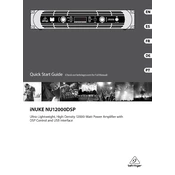Behringer NU12000DSP Quick Start Guide


To configure the NU12000DSP for stereo, connect the left and right outputs of your audio source to the inputs on the amplifier. Use the DSP menu to set the amplifier mode to 'Stereo' and adjust the crossover settings as needed for your speakers.
If the NU12000DSP overheats, ensure it is placed in a well-ventilated area. Clear any obstructions around the ventilation openings and check that the cooling fan is operational. Reduce the load by lowering the volume and ensure the impedance matches the speaker specifications.
To update the firmware, download the latest version from the Behringer website. Connect your computer to the amplifier via USB, open the update utility software, and follow the on-screen instructions to complete the update process.
To perform a factory reset, power off the unit. Hold down the 'Setup' button while turning the power back on. Continue holding the button until the display reads 'Resetting', then release. The unit will reboot with factory settings.
Check that all cables are properly connected and that the amplifier is powered on. Ensure the input source is correctly selected and the volume is turned up. Verify that the mute function is not activated and inspect the speaker connections for any faults.
Regular maintenance includes cleaning dust from the ventilation grilles and ensuring all connections are secure. Periodically check the firmware for updates and inspect the power cables and speaker wires for any signs of wear or damage.
Access the DSP menu, navigate to the crossover settings, and select the desired crossover point frequency. Adjust the slope and type (e.g., Butterworth, Linkwitz-Riley) to match your speaker's specifications and application needs.
Yes, to use the NU12000DSP in a bridged mono configuration, connect the input signal to channel A, and use the 'Bridge' mode in the DSP settings. Connect the speaker to the positive output terminals of channels A and B.
Ensure the amplifier is used within its specified impedance range to prevent overloading. Avoid exposing the unit to extreme temperatures or moisture, and ensure ventilation is adequate to prevent overheating.
For optimal audio quality, use high-quality cables and ensure all connections are secure. Properly configure the DSP settings according to the speaker specifications and room acoustics. Regularly update the firmware for the latest enhancements.